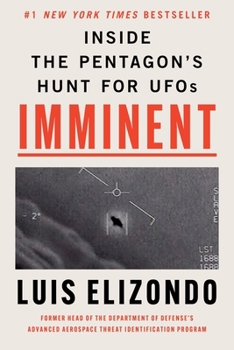
Turns out the “kooks” were right
We here at the Pentagon would like to clarify our denials of the past seventy years regarding Unidentified Flying Objects. We staunchly maintain that UFOs do not exist, but, ahem, well, Unidentified Anomalous Phenomena (UAP) do. We apologize for any confusion.
For more than a half century, UFOs have been the Pentagon’s best kept non-secret. They have debunked and dismissed hundreds of credible sightings and discredited witnesses as kooks or frauds or crazy. What’s surprising is that it was done so brazenly. Over two weekends in 1952, multiple UAP were seen in Washington DC, including over the White House. They were viewed by hundreds of eyewitnesses and appeared on the front pages of major newspapers. Air Force pilots pursued and even fired at them. A thorough investigation found that it was “flocks of birds.”
In March 1966, Michigan neighborhoods saw multiple strange craft over several days that “dove, hovered, climbed, and disappeared—only to reappear.” Government investigators announced it was “swamp gas.”
Read more...
Oh, and that Roswell incident in 1947? Turns out there was a crash, and bodies were recovered. So, it wasn’t “weather balloons” as the Army reported (Our bad!) Even during World War II, Allied and Axis pilots reported mysterious “orbs of light” around and in their craft so regularly that they were nicknamed “foo fighters.”
You mean they’re real? was Luis Elizondo’s first reaction when he became head of
the government’s Advanced Aerospace Threat Identification Program (AATIP) in 2010. Prior to this position, he had overseen counterespionage and counterterrorism investigations for the Department of Defense and worked for the Office of the Director of National Intelligence. You’d think someone would have told him.
Imminent recounts Elizondo’s efforts to uncover and then reveal the extent of UAP encounters, not so he could finally get on "Oprah," but from his concern for national security. He fears we may be “playing checkers against an enemy who (has) already mastered three-dimensional chess.” The technology—and the physics behind such extraordinary technology—is far beyond anything we possess or even fully comprehend.
And his concern seems legitimate: There are multiple reports of UAP hovering over US nuclear missile silos. And not just hovering. In March 1967, at Malmstrom Air Force Base in Montana, its intercontinental ballistic missiles “went offline, one after another.” Even more disturbing, similar UAP appeared over a Soviet missile base in Ukraine in 1982, where the launch sequence switched on (!) without any humans entering the launch codes.
He notes that each time a nuclear reactor has melted down (Three Mile Island, Chernobyl, Fukushima) UAP have been witnessed in the areas for days or months afterward, even calling nuclear reactors “UAP magnets.”
In the 21st century, it has become harder to deny UAP. In November 2004, the US Navy’s Nimitz Carrier Strike Group encountered a number of objects descending from high altitudes, hovering, then zipping away at theoretically impossible speeds. Over several days, these egg-shaped, noiseless vehicles were “seen by six naval aviators, tracked by multiple radars on multiple platforms, and videotaped by an advanced military infrared targeting system.” Swamp gas did not seem likely. (You can watch the government’s declassified UFO videos on YouTube.)
Other nations have been more forthcoming in investigating and publicly acknowledging these encounters. For example, between 1977-1978, the Brazilian military compiled more than 3500 case files on UAP in their northern Colares region.
Largely by the efforts of Elizondo and courageous colleagues, the truth about the frequency and nature of these encounters has become public. He openly admits, “You might be thinking this all sounds crazy. I’m not saying it doesn’t sound crazy. I’m saying that it’s real.”
We are left with the puzzling mystery that first prompted his concerns: We know that they are. We just don’t know what they are. Are they extraterrestrial? Extradimensional? Intelligent beings from the future?
The implications are immense and profound. In a foreword to the book, Christopher Mellon, former US Deputy Assistant Secretary of Defense for Intelligence, writes that these revelations “may soon cause humanity to reframe its view of itself and our place in the cosmos.” We may be on the cusp of a paradigm shift unlike any other in human history. And it may be imminent.
Stay tuned.
At the dawn of the nuclear age, UAP started appearing in greater numbers—and sometimes they crashed. Roswell was one of those incidents. A UAP fell that day in the vicinity of a government test facility in New Mexico and broke into two crash sites. At first, government investigators assumed that the Roswell craft were from another nation, possibly some sort of reconnaissance mission gone awry. But within hours, the US Army realized the truth, that these craft were not made by humans.
from Imminent
Luis Elizondo
William Morrow
This review first appeared in The Columbia River Reader (November 25, 2024.) Reprinted with permission.



